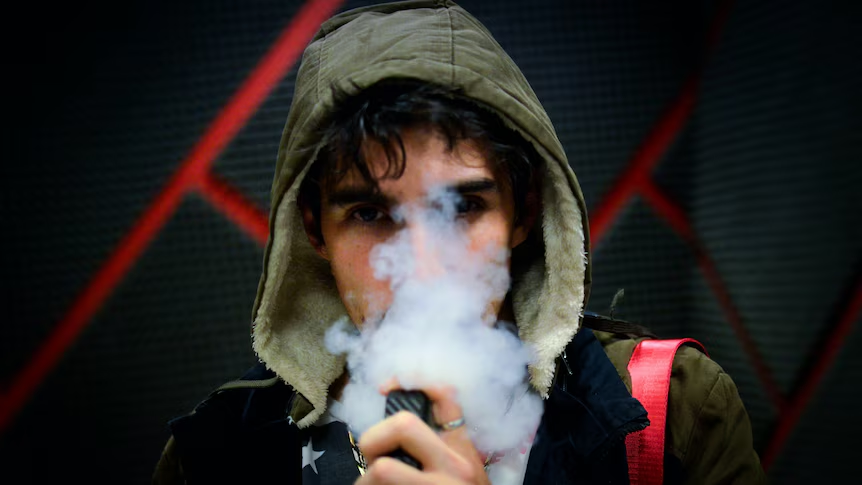
A 25-year-old postgraduate student at the University of Sydney, describes his first vape with a shrug: “It was at a party. Someone passed it to me, and I just tried it. The flavour was mango or something.” That was two years ago. Since then, vaping has become “just normal”, not just for Chris, but for most of his friends.
Among Australians, vaping had gained popularity in recent years despite the legislative restrictions and growing public awareness. In Australia, vaping has not just become a concern of public health but a cultural crisis. A news research in a popular public health journal found that compared to smoking, Australian teenagers are much more likely to engage with vapes.
The loopholes in vaping regulation, vigorous marketing, and the influence of social media to make youth addicted to nicotine consumption still exist. This issue is of utmost importance as it no longer looks at vaping as a problem, but how it is regulated before it becomes a bigger one.
A Growing Trend
Vapes or electric cigarettes are personal vaping devices that can be inhaled rather than smoked. This inhaled aerosol can be flavored, containing a lot of toxic chemicals and nicotine.
Chris said, “It’s not hard,” Chris admits. “You just message someone on Snapchat. They deliver it to your house like Uber Eats.”

Looking at the huge population of Australia, it is pointed out in ABC News that 3.5 million Australians are in the age group of 14 and above to engage with either smoke or vape. In the year 2022-2023, among the age group of 18-24 years in Australia, the highest, 49% of people were seen to use e-cigarettes (refer to image 1). Vaping is not just enlarging the traditional market of tobacco companies, rather, it is creating a whole new spectrum of addiction.

Compared to vaping, or both the use of smoke and vaping, a higher percentage of Australians were seen to be addicted exclusively to smoking. Above the age of 14 years, 49% were seen as addicted to exclusive smoking, but the rates of vaping were higher in the age groups 18 to 34 years (refer to Image 2). Therefore, exclusive smoking might be high among older people above 50, but exclusive vaping was seen to be more prevalent among the younger people. A 17-year-old told The Conversation, “No one buys the non-nicotine devices…they don’t give head spins”. Public health response is urgently needed in such situations where occasional users get addicted to vapes.
Listen to Chris’s perspective on vaping:
In this audio, Chris shares his experience and reflections on vaping culture among young Australians.
Health Risks and Regulatory Responses for Young Brains
Vaping can affect young people in the form of damaging their lungs and young brains that are still developing until the age of 25 years. There can be a range of harmful chemicals that one is exposed to with vaping. This includes toxins such as formaldehyde and heavy metals, favouring chemicals known as diacetyl, and also minute particles that can be deeply inhaled into the lungs.
While the laws are getting tougher, so is youth resistance.
“People don’t stop just because the law changes,” Chris says. “They find other ways.”
There is a cause-and-effect relationship identified between vaping and symptoms of mental health. A greater number of depressive symptoms was seen to be associated with sustained vaping over time compared to teenagers to did not vape. Stress, anxiety, and suicidal tendencies can act as highly risk factors associated with the increasing and continuation of vaping.
The Marketing Power
Australia stands out to be a country that introduced a prescription model to access vaping products. To protect the health of the Australian youth, certain vaping laws have been enforced in Australia. On 1 July 2024, a law changed the selling of all vapes and vaping products, claiming that whether a product contains nicotine or not can only be sold in a pharmacy to help people quit smoking or regulate nicotine dependence.
Chris believes schools could do more. “Right now it’s all punishment, suspensions, phone calls home. But that just makes people hide it better,” he says. “If someone’s addicted, they should be offered help, not just detention.”
It has been seen that since the introduction of the Therapeutic Goods Administration (TGA) working in collaboration with the Victoria Police, a vital role has been played by them to seize 200,000 vapes that cost more than $8 million, on 24th October 2024, from a warehouse in Box Hill, South Victoria. This operation is supporting the reforms introduced under the Therapeutic Goods and Other Legislation Amendment (Vaping Reforms) Act 2024. This act, introduced on July 1, has identified restricted sale of vapes to Australian pharmacies, prohibited sale in retail outlets such as tobacconists and convenience stores.
But what about the media influence over vape use? Here is what is known.
Despite countries such as Australia having restrictions on advertising, e-cigarette advertising has been widespread. A survey conducted in four countries, including Australia, which restricts e-cigarette advertising, revealed 85% exposure to similar advertisements. Under the U.S. Federal Trade Commission, since 2019, the reports from major e-cigarette manufacturers have revealed a five-fold increase in their expenditures on advertising. A part of it also revealed the crucial role played by social media in the aggressive promotion of e-cigarettes through online advertisements. Social media is a low-cost way to target current and potential users. Youth are mostly the targets of this form of advertising and marketing.
Chris thinks young people need to be involved in the conversation. “Let actual teens talk about why they quit, or how they feel. Not just doctors or teachers. People our age get it.”
A Way Forward
Youth vaping in Australia is hence more than a trend now. It is a fast-moving challenge that requires more than the rules under the recent legislative changes. It will need smart communication, constant education, and expressive engagement with the young people themselves. A real conversation with the young people can be a real solution rather than trying to regulate their choices. Policy needs to be combined with public education, digital literacy, and health equity to stop the growth of vaping culture further.
References
Australian Institute of Health and Welfare. (2024). Young people’s use of vapes and e-cigarettes. https://www.aihw.gov.au/reports/smoking/young-peoples-vapes-e-cigarettes
Borys, S. (2023, June 2). Over 3.5 million Australians aged 14 or over vape or smoke, new data has revealed. ABC News. https://www.abc.net.au/news/2023-06-02/smoking-vaping-on-the-rise-in-young-australians/102425832
Cancer Council. (2024). Aussie teens who have vaped are five times more likely to then try smoking. https://www.cancer.org.au/media-releases/2024/aussie-teens-who-have-vaped-five-times-more-likely-to-then-try-smoking
Commonwealth of Australia. (2023, December 21). Young people and vaping. Australian Government Department of Health and Aged Care. https://www.health.gov.au/topics/smoking-vaping-and-tobacco/audiences/young-people-vaping#how-vaping-affects-young-people
Commonwealth of Australia. (2024, October 29). $8 million of illicit vapes located in collaboration between TGA and Victoria Police. Therapeutic Goods Administration (TGA). https://www.tga.gov.au/news/media-releases/8-million-illicit-vapes-located-collaboration-between-tga-and-victoria-police
Freeman, B. (2023). Vaping and behavior in schools: what does the research tell us? The Conversation. https://theconversation.com/vaping-and-behaviour-in-schools-what-does-the-research-tell-us-204794
NSW Health. (2022, May 4). The Facts about Vaping – for Young People – Tobacco and Smoking. https://www.health.nsw.gov.au/tobacco/Pages/vaping-factsheet-young.aspx
Tobacco in Australia. (2015). 18.2 Advertising and promotion of e-cigarettes – Tobacco in Australia. https://www.tobaccoinaustralia.org.au/chapter-18-e-cigarettes/18-2-advertising-and-promotion
Truong, M., & Cotton, E. (2023). The impact of vaping on adolescent mental health. Aifs.gov.au. https://aifs.gov.au/resources/policy-and-practice-papers/impact-vaping-adolescent-mental-health




Be the first to comment